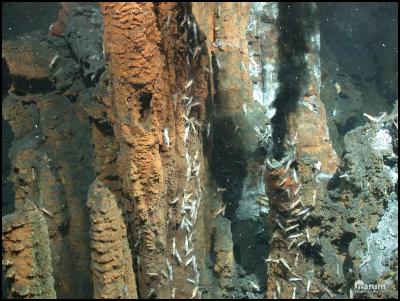Submarine volcanoes give up their secrets
23 January 2017
Submarine volcanoes give up their secrets

Twenty-metre high chimneys belching out hot acidic mineral-rich fluids, forests of long-neck barnacles clinging to craggy rock formations, and beds of mussels lining vertical rock walls.
These are just some of the otherworldly sights witnessed by a scientists fresh back from a voyage investigating submarine volcanoes in the Kermadec Arc, northeast of New Zealand.
The joint German-New Zealand expedition arrived in Auckland over the weekend on the German research ship RV Sonne after four weeks at sea probing five undersea volcanoes along the 2500km-long Arc that stretches between the Bay of Plenty coast and Tonga.
There are about 80 volcanoes occurring in nearly a straight line along this Arc, which marks the collision zone between the Pacific and Australian tectonic plates. Only four of the 80 stick out of the water, forming the Kermadec Islands. All the others are underwater volcanoes. This is one of the most active stretches of seafloor volcanism in the world. Many of the volcanoes have multiple hydrothermal vents where hot, mineral-rich fluids billow continuously into the ocean.
The aim of the expedition was to investigate seafloor vents and their dense, metal-rich fluids and find out how they influence the chemistry of the seawater and the diverse marine life along the Arc. Scientists also wanted to see the extent of marine species migration between volcanoes.
All of the volcanoes had been mapped before and some had been probed by ROVs. This expedition successfully gathered new information, including observing new geological and biological features that had either changed or had not been seen on previous voyages. Some of the volcanoes were mapped at higher resolutions than previously. The 39 scientists on the Sonne hail from five German research organisations and GNS Science. Their main tool during the voyage was a remotely operated vehicle (ROV) called Quest 4000 which completed 19 dives.
As well as taking video footage, it sampled the hot fluids, and collected biological material and rock samples which the scientists studied on board.

The five volcanoes investigated were Rumble III, Brothers, Kibblewhite, Haungaroa, and Macauley Cone.
Chief Scientist Andrea Koschinsky, of Jacobs University in Bremen, said it was really spectacular to see metal-rich fluids at 300 degrees Celsius shooting out forcefully from the seafloor and how marine life thrived under these conditions.
“The highlight for me was entering our operations room for the first time to see video footage being sent back from our ROV showing large chimneys at Brothers volcano at a depth of 1.6 kilometers. I have not seen such a diverse and fascinating range of seafloor hydrothermal vents in more than 25 years of doing this work. It was truly amazing.”
Marine geochemist Cornel de Ronde, of GNS Science, said they discovered chimneys at Brothers Volcano pumping out fluids at 312 degrees Celsius – a new temperature record for vent fields in the Kermadec Arc. “This expedition has added greatly to our knowledge concerning seafloor hydrothermal systems of the Kermadec Arc. New vent sites at Brothers, Haungaroa and Kibblewhite, with temperatures up to 312°C and chimneys standing 20m up from the seafloor, confirm that the Arc is host to numerous areas of copper and zinc-rich mineralisation,” Dr de Ronde said.
Some of the fields of chimneys were extensive, measuring about 100 square metres. At Brothers volcano there were at least five such fields. Dr de Ronde said the 20m-high chimneys at Brothers were the tallest he had seen in about 30 years of doing this research.
“Tall chimneys eventually become unstable and topple and are replaced by new ones that grow steadily in a natural cycle.”
Dr de Ronde said the chemistry of the vent fluids at the different volcanoes was widely divergent, with some fluids having a pH of 1.1 – similar to battery acid. Wolfgang Bach, a geologist at Bremen University, said this was his first visit to the Kermadec Arc and he was impressed with the range of volcanic settings and their accompanying hydrothermal systems.
“The northwest caldera site at Brothers Volcano was the most exciting seafloor vent site I have ever visited in my career. The exposure of rocks and veins beneath the actual chimneys was unique and gives us great insight into the working of these hydrothermal systems at depth.”
A blog describing the main activities of the expedition can be found at: geschichten.ptj.de/so253-en
END


 Seafood New Zealand: Seafood Situation Saved By A Sausage: New Plymouth Locals Innovate, Using Crayfish Bait
Seafood New Zealand: Seafood Situation Saved By A Sausage: New Plymouth Locals Innovate, Using Crayfish Bait Takeovers Panel: Takeovers Panel Convenes Meeting To Inquire Into The Acquisition Of Shares In NZME Limited
Takeovers Panel: Takeovers Panel Convenes Meeting To Inquire Into The Acquisition Of Shares In NZME Limited WorkSafe NZ: Conveyor Belt Death-Trap Was A Danger In Plain Sight
WorkSafe NZ: Conveyor Belt Death-Trap Was A Danger In Plain Sight Commerce Commission: 2degrees Fined $325,000 For Misleading Claims About ‘Free’ Aussie Business Roaming
Commerce Commission: 2degrees Fined $325,000 For Misleading Claims About ‘Free’ Aussie Business Roaming  Natural Hazards Commission: Hub Launched To Empower Architects And Engineers To Build Above Code
Natural Hazards Commission: Hub Launched To Empower Architects And Engineers To Build Above Code Harmony Energy: Ceremony Heralds Start Of Construction On New Zealand’s Largest Solar Farm Project
Harmony Energy: Ceremony Heralds Start Of Construction On New Zealand’s Largest Solar Farm Project



